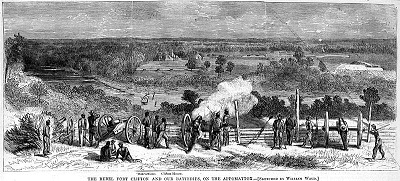
Courtesy of Harper's Weekly, Library of Congress; William Waud, artist
Located within the Fort Clifton Historic Park, the Fort Clifton Archaeological site contains the intact archaeological remains of the fort and the Clifton house. Fort Clifton served as a Confederate fortification during the Civil War. It is located on the western bluffs of the Appomattox River. The fort was the site of three major confrontations in 1864 during the Petersburg campaign.
The property on which the site is located was patented in December 1620 by Charles Magnor. The upland portion of the 650 acre tract was known as Conjurer’s Field, the present day location of the Conjurer's Field Archeological District. Throughout the 1600s, 1700s, and 1800s the property was used for agriculture. By the mid-1800s, the property became known as Clifton tract. It was owned by Ottoway and Elizabeth Hare. The Hare’s sold it to Alexander Jones, who willed it to his brother James. Right before the war began, James sold it to William Crow. In 1864, the Confederate army built a line of defenses on the property to protect Petersburg and Richmond. Brigadier General Colton described the eight mile semi-circle defenses as being only slightly noticeable. The first battle at the fort was on May 1864. Major General Pickett ordered General Johnson to make an entrenchment. By the next morning, May 8th, Johnson’s artillery and infantry crossed Swift Creek and began fortifying their position. The fort was barely completed when battle broke out. According to General Johnson’s report, on May 9th, five gunboats advanced and fired on Fort Clifton. Landside fighting accompanied the naval confrontation. According to Confederate Colonel Fulkerson, Union troops appeared on the bluff opposite of the fort. Confederate troops returned fire and drove Union troops back. There were two casualties from the battle. In June 1864, Fort Clifton was attacked again. Commander Amos Foster of the U.S. Steamer, Commodore Perry, opened fire on Fort Clifton. Shots fired by the Confederates fell short. After three hours of shelling, the Confederates retreated. An explosion of a Parrott gun aboard the steamer killed several men who are buried at Point of Rocks. On June 16, Union General Butler reported that Union gunboats were firing on Fort Clifton. By 4:30 p.m. Union artillery Captain Osbourne communicated to his superiors that there had been no responsive fire from Fort Clifton for two hours. At 7 p.m. General Graham sent two boats within 150 feet of the fort that were fired upon. After the war ended, William Crow lost the farm in an 1869 chancery suit. The Clifton tract was purchased by the Donnan’s in 1871 and re-sold in quick succession several times.
Fort Clifton Archeological Site was listed on the National Register of Historic Places on February 3, 1981. It is located within the Fort Clifton Park, at 5501 Conduit Rd. Colonial Heights, VA 23834. For more information about the fort, its history, and visiting, please visit the Fort Clifton Festival or call (804) 520-9390.
Last updated: December 13, 2018
